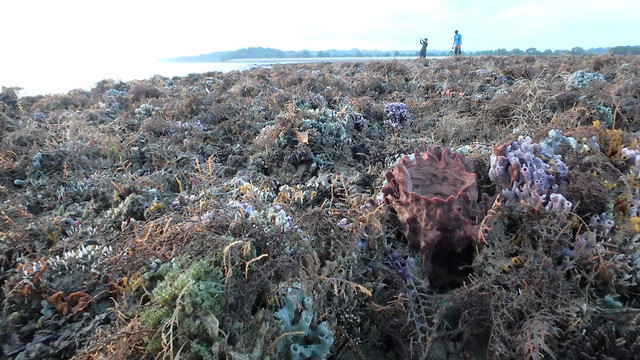 |
| index of concepts |
| ecosystems | rocky | sandy | seagrass | coral rubble | coral reef |
| Coral
rubble ecosystem updated Dec 2019 Before you reach living reefs on an intertidal area, there is often a stretch of shore where there are more dead than living corals. An area with such coral rubble may appear rather dead but is actually full of life if you take a closer look. Dead corals provide a place for animals to cling to, and hiding places in crevices and nooks and crannies. Because such coral rubble areas tend to be found below the low water mark and are only exposed at low spring tides, more delicate animals may be found here. Where are the animals? Many coral rubble dwellers are well camouflaged. Some are only active at high tide. At low tide, these clamp up in their shells or hide in a cool, moist spot. Others that are active at low tide are usually seen only when it is dark, or on a cool, overcast day. |
 A marvelous variety of animals growing on coral rubble at Beting Bronok. |
Home on the Rubble: Coral rubble provide a firm surface for lots of animals. An undisturbed coral rubble area may have spectacular growths of sponges, sea fans and hydroids. The natural holes and channels in dead coral provide a great home for many small animals. The underside of coral rubble provides shelter for a vast variety of animals from tiny snails, flatworms, to larger crabs and fishes and octopuses. Larger sea anemones and placid sea cucumbers as well as chunky sea stars may also hide under rubble. Don't roll the rubble: Because coral rubble is usually so encrusted with life, it is best not to turn rubble over to look underneath. Besides which, a poisonous (and frightened) animal may be hiding there, and both you and the animal may come to harm. Not just dead corals: In between the coral rubble, there may be large living soft corals as well as smaller living hard corals. Where can we explore coral rubble areas in Singapore? Labrador has the last large mainland coral rubble area. Among our northern islands, there is a small stretch at Chek Jawa, Pulau Ubin. Also at Pulau Sekudu. Almost all our Southern islands have coral rubble areas with a vast stretch at Pulau Semakau, as well as some at Kusu Island. |
Links
|